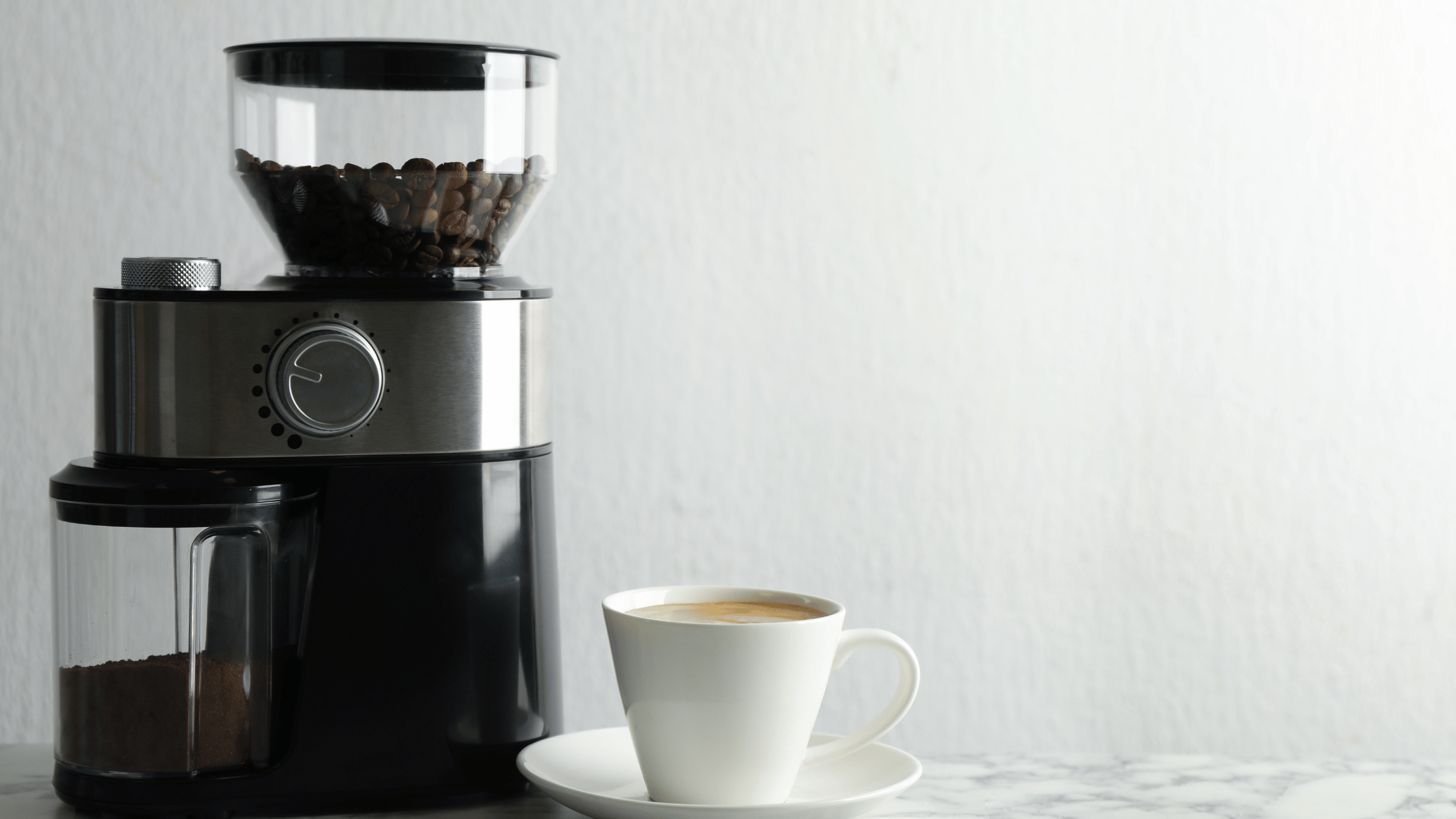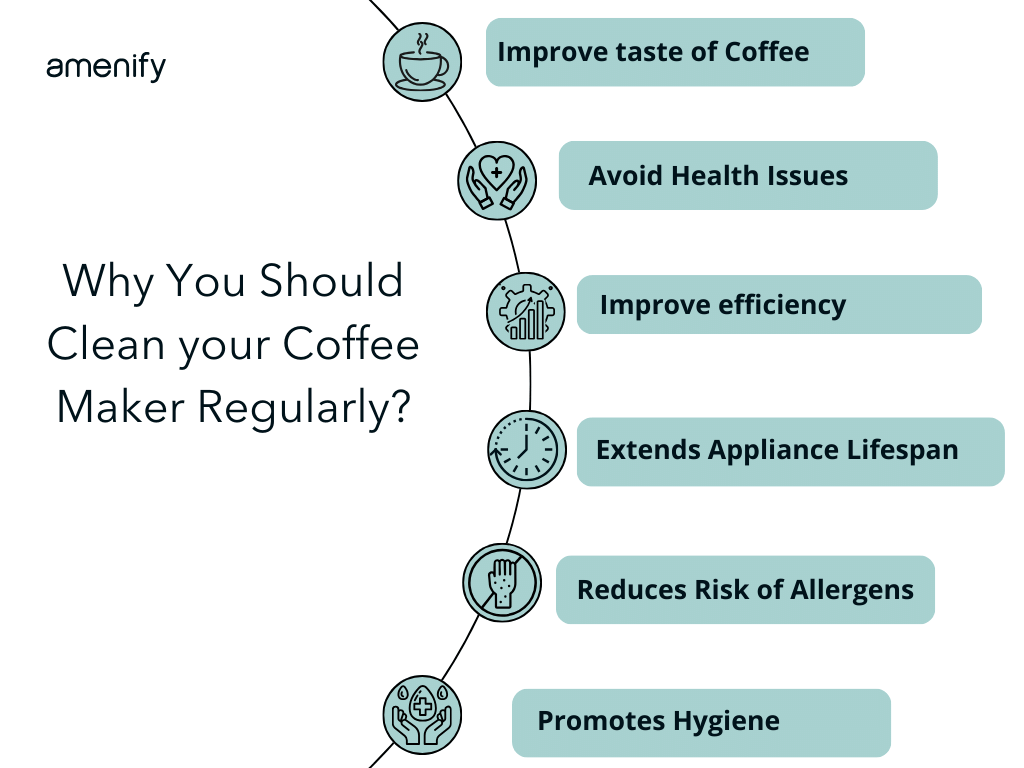How to Clean a Coffee Maker?
Waking up to a perfectly brewed coffee is simply a pleasure, but the task of cleaning the coffee maker isn't as enjoyable. Fortunately, there are expert tips on how to clean a coffee maker so that you can enjoy a pot of fresh, flavorful coffee every morning.
To maintain the best coffee maker performance, regular upkeep is essential. In addition to keeping the exterior clean and dust-free, it's crucial to care for the often-overlooked internal parts. This task, while not overly complicated, is a vital aspect of your routine kitchen cleaning.
Lisa Yakas, a qualified microbiologist and expert in consumer product safety at NSF, reveals that the coffee machine reservoir is one of the leading breeding grounds for germs in our households. This guide will help you with different ways to clean coffee makers thoroughly. The process is quick, and you'll instantly notice the advantages—both performance of your coffee maker and in the quality of your coffee.
Cleaning Supplies You Will Need
Keeping your coffee maker clean is crucial for optimal performance and taste. Here's a concise list of supplies you'll need for both basic and deep cleaning.
Basic Supplies
White Vinegar
Water
Soft Cloth or Sponge
Dish Soap
Additional Supplies
Baking Soda
Q-Tips or Cotton Swabs
Toothbrush
Microfiber Towel
Rubbing Alcohol
Paper Towels
Funnel
Descaling Solution
Filtered Water
Lemon Juice
Rubber Gloves
Why Cleaning Your Coffee Maker Matters?
Cleaning your coffee maker is not just about aesthetics; it has significant implications on the quality of your coffee and the longevity of your appliance. Here's why:
Taste: Over time, coffee residues and hard water minerals build up in your coffee maker, leading to stale or rancid flavors and a metallic taste. Regular cleaning and descaling are vital to maintain the quality of your coffee.
Health: Coffee makers provide ideal conditions for mold and bacteria growth, posing health risks if not cleaned. Mold can thrive in dark, damp areas like the water reservoir. To ensure safety and quality, clean your coffee maker regularly to prevent harmful pathogens from developing.
Efficiency: Hard water mineral scaling has a twofold impact on your coffee maker. It slows the brewing process by clogging water lines and can damage critical components like heating elements. Neglecting this buildup can lead to costly repairs or replacement. Regular cleaning and descaling are crucial for machine efficiency and longevity, safeguarding your investment.
Extends Appliance Lifespan: Accumulated mineral deposits, especially in areas with hard water, can damage the internal components of a coffee maker. Cleaning the machine helps prevent clogs, corrosion, and other issues, prolonging its lifespan and saving you from costly repairs or replacements.
How to Clean a Coffee Maker?
Make sure to clean your coffee machine on a monthly basis, especially if you're a daily coffee enthusiast. If less frequent, clean every three to six months. If you see residue or taste issues, clean it right away.
Follow this guide to ensure your machine operates at its best, offering you a fresh, flavorful cup every time.
How to Clean Coffee Maker Regularly?
Unplug and Disassemble: The first step is to prioritize safety. Unplug your coffee maker to eliminate any risk of electric shock. Once unplugged, proceed to disassemble the various removable parts like the carafe, filter basket, and lid. Place these items aside for separate cleaning.
Pre-treat Stains: Before washing, examine the removable parts for any stubborn coffee stains or mineral deposits. For tough stains, consider soaking the parts in warm, soapy water for 10–15 minutes to help loosen the residues.
Wash Removable Parts: Fill a sink or basin with warm water and add a few drops of mild dish soap. Gently scrub each part with a soft cloth or sponge, paying extra attention to corners and crevices where coffee grounds and oils may accumulate. After washing, rinse each piece thoroughly under running water to remove soap residues.
Dry Removable Parts: Use a clean towel to dry the washed parts completely. It's essential to ensure they are dry to prevent any potential mold or bacterial growth when reassembled.
Wipe Down the Exterior: For the external parts of the coffee maker, moisten a cloth with water and wring it out to make it damp. Wipe down the coffee maker's exterior, focusing on areas where coffee spills, stains, or dust may have collected. Don't forget the warming plate, as coffee spills here can become baked on and difficult to remove over time.
Check Electrical Components: While the machine is unplugged, take a moment to inspect the cord and plug for any signs of wear or damage. This is crucial for ensuring the machine's safe operation.
By following these steps, you'll clean your coffee maker better, making it last longer and enhancing your coffee's quality and taste.
Also read, How to clean oven?
How to Clean Coffee Maker with Vinegar?
Prepare the Coffee Maker: Start by removing any old coffee grounds and emptying the carafe. Make sure the machine is unplugged before you begin the deep cleaning process.
Create Vinegar Solution: Mix equal parts of white vinegar and water in a jug to create your cleaning solution. This 50/50 mixture is effective for removing mineral deposits and cleansing internal components.
Pre-Soak Filter:Before brewing your coffee, enhance its flavor by soaking the reusable filter in a vinegar solution for approximately 10 minutes. This will help dislodge any stubborn residues.
Run a Vinegar Cycle: Pour the vinegar-water mix into the water chamber up to the max fill line. Begin a full brew cycle, then switch off the machine halfway and let it sit for 30 minutes to an hour. Using vinegar helps to effectively remove stubborn buildup.
Complete the Vinegar Cycle: After the soak time has passed, resume the brew cycle and allow it to finish. Discard the vinegar solution safely down the sink.
Inspect and Wipe: Once the vinegar cycle is complete, remove and inspect the carafe and filter basket. Use a sponge or cloth to wipe away any remaining deposits that may have been loosened but not completely removed.
Rinse Thoroughly: To ensure that all vinegar residues are fully removed, run at least two to three full cycles using only plain water. Sniff and taste the water from the final cycle to confirm that no vinegar aroma or flavor remains.
Dry Components: After the rinsing cycles are complete, disassemble any removable parts and dry them thoroughly with a towel. Ensure they are fully dry before reassembling to prevent mold or bacterial growth.
By following this guide on how to clean a coffee maker, you'll eliminate mineral buildup, address coffee oils, and remove contaminants, keeping your coffee maker in top condition.
Also read, How to Clean Microwave?
How to Descale a Coffee Maker?
Assess the Need for Descaling: Modern coffee makers often come with a descaling indicator that alerts you when it's time to remove mineral buildup. If your machine lacks this feature, set a schedule to descale every three months, or more frequently if you have hard water.
Choose Your Descaling Agent: You can either purchase a commercial descaler designed for coffee makers or opt for a DIY approach using a white vinegar and water mixture. Commercial descalers often contain citric acid, which is effective for removing mineral deposits without leaving a lingering smell.
Prepare the Coffee Maker: Before starting the descaling process, make sure to unplug your coffee maker and remove any remaining coffee grounds or water. Reassemble the removable parts and plug it back in.
Run the Initial Descaling Cycle: Fill the water chamber with your chosen descaling solution, then initiate a brew cycle. Some models have a specific "descaling" setting. Allow the cycle to complete fully.
Let it Soak: If you are using vinegar, pause the cycle halfway through and allow the machine to sit for about 30 minutes to an hour. This soaking period helps break down stubborn mineral deposits.
Finish and Discard: Complete the descaling cycle and discard the used solution in a safe manner.
Check for Residues: Inspect the carafe and other components for any leftover mineral deposits. If necessary, repeat the descaling process.
Thorough Rinsing: To eliminate any solution residues and odors, run at least two or three cycles of plain water through the machine. Some people prefer to use filtered water for this step to ensure that all traces of the descaling agent are removed.
Dry and Reassemble: Once you've confirmed that no descaling solution remains, disassemble any removable parts and dry them completely before reassembling.
Test: Brew a small batch of coffee and taste it to make sure the descaling process was successful. If the coffee tastes off, you may need to repeat the descaling process or consult your coffee maker’s manual for further troubleshooting.
Regular descaling is crucial for the longevity and performance of your coffee maker. By adhering to these comprehensive steps, you can ensure that your machine remains in excellent working condition, providing you with the best coffee experience possible.
20 Maintenance Tips for Prolonging the Life of Your Coffee Maker
Maintaining your coffee maker is essential for both its longevity and the quality of coffee it produces. Here are 20 simple yet effective tips to keep your machine running smoothly and your coffee tasting great.
Tip #1: Use Filtered Water: Filtered water prolongs your coffee maker's life by reducing mineral buildup, cutting down on descaling needs. Plus, it yields a cleaner, tastier cup of coffee.
Tip #2: Empty the Carafe Promptly: Make sure to empty your coffee carafe immediately after brewing. Lingering coffee can lead to residue and mold, affecting taste and hygiene. It also prevents overcooking, preserving the coffee's original flavor.
Tip #3: Remove Used Coffee Grounds: After brewing, remove and dispose of used coffee grounds immediately. This prevents mold and bacteria growth in the coffee maker and maintains the freshness of future brews.
Tip #4: Regular Inspection: Set a regular inspection schedule to spot mold, odors, or mechanical problems early, saving time and money by preventing complex repairs.
Tip #5: Clean Removable Parts: Consistently wash any removable parts such as carafes and filter baskets with warm, soapy water. This action helps to remove accumulated coffee oils and residue, which, if left unaddressed, can lead to poor-tasting coffee and potential mechanical issues.
Tip #6: Wipe Down Exterior: Regularly wipe the machine's exterior with a damp cloth for cleanliness and to check for issues like leaks or wear and tear.
Tip #7: Monthly Deep Cleaning: Allocate time each month for thorough cleaning. Use a vinegar-water solution to combat residue and mineral buildup inside the machine. This maintains peak efficiency and extends its operational life.
Tip #8: Check Seals and Gaskets: Periodically inspect seals and gaskets for any signs of wear or leaks. Seals and gaskets are essential for maintaining pressure and preventing leaks, and their integrity is crucial for the machine's proper functioning. Consult the manufacturer's guidelines for when to replace these components.
Tip #9: Store Properly: Clean your coffee maker thoroughly before long-term storage in a cool, dry place. It helps to prevent mold and dust buildup and ensure it's ready for future use.
Tip #10: Use Quality Coffee: High-quality coffee produces fewer oils and residue, reducing cleaning needs and extending your machine's life, saving time and effort.
Tip #11: Watch for Rusting: Rust can taint coffee and harm your machine, especially in models with exposed metal parts. Small rust spots can be treated with a rust remover, but severe may require part replacement or a new machine.
Tip #12: Test Water Temperature: Monitor brewing water temperature for optimal flavor. Use a thermometer to ensure it's within 195–205 °F. Temperature fluctuations may indicate cleaning or repairs are needed.
Tip #13: Calibrate Grinder: Calibrate integrated grinder for desired grind size. Over time, settings can drift. Regular calibration maximizes coffee bean potential and grinder lifespan.
Tip #14: Check Electrical Components: Regularly inspect the power cord and plug for any signs of fraying, burns, or other damage. Electrical issues pose not just a risk to your machine but also can be a safety hazard. Timely identification can lead to quick repair or replacement, avoiding more serious complications.
Tip #15: Examine Water Lines: For plumbed coffee machines, regularly check water lines for leaks or clogs. Ignoring such issues can lead to more severe problems, such as water damage to your kitchen or internal damage to the machine. Regular inspections can preempt costly repairs.
Tip #16: Replace Filters: If your coffee maker uses water or coffee filters, always replace them based on the manufacturer's guidelines. Neglected filters can compromise the taste of your coffee and put extra strain on your machine, reducing its lifespan.
Tip #17: Monitor Brew Time: Keep tabs on the amount of time it takes to brew a coffee pot. A significant increase in brewing time often indicates that the machine needs descaling or that internal components may require cleaning. Addressing these issues promptly can prevent more serious problems down the line.
Tip #18: Keep it Dry: After every cleaning cycle, take a moment to thoroughly dry all components, such as carafes and baskets. Water accumulation can foster mold and bacterial growth, posing a health risk and potentially affecting the machine’s operation.
Tip #19: Inspect Drip Tray and Check Boiler: Clean drip tray to prevent odors and health risks. Wash removable trays. For boilers, descale as per manufacturer's guidelines to avoid inefficiency and costly repairs.
Tip #20: Consult User Manual: Refer to the user manual for model-specific cleaning tips and maintenance to maximize efficiency and longevity.
By adopting these maintenance practices, you can extend the lifespan of your coffee maker, ensuring it continues to deliver high-quality coffee.
How Amenify Can Help?
Amenify, a top provider of professional cleaning services, caters to over 2 million homes and has earned an impressive 15,000 five-star ratings. Our certified and highly skilled cleaning experts specialize in maintaining appliances like coffee makers. By selecting our services, you're choosing both convenience and top-notch quality, ensuring your coffee maker stays in pristine condition without the need for DIY efforts. What distinguishes us is our dedication to excellent cleaning practices, as we exclusively use safe and sustainable cleaning products, providing you with peace of mind.
FAQs on How to Clean Coffee Maker
-
Combine 1/4 cup of baking soda with a cup of warm water and initiate a brew cycle in the coffee maker. Follow by flushing out the baking soda solution with one or two cycles of clean water through the machine.
-
Yes, vinegar is an effective cleaning agent for coffee makers. It helps remove mineral deposits, coffee oils, and residue that can accumulate over time. The acid in vinegar dissolves these buildups, ensuring a clean and odor-free coffee maker. It's crucial to follow proper cleaning procedures, such as diluting vinegar with water to prevent any lingering taste or smell. Regular vinegar cleaning can extend the life of your coffee maker and ensure that your coffee tastes fresh and isn't impacted by residue buildup.
-
To clean a 12-cup coffee maker with vinegar, typically use a mixture of 4 cups of vinegar and 8 cups of water. To effectively remove any vinegar residue, pour this solution into the water reservoir, run a brew cycle, and then complete the process with two additional cycles using clean water to thoroughly rinse.
-
To clean a coffee maker with lemon juice, mix a solution of 1/2 cup of lemon juice and 1/2 cup of water. Pour this mixture into the water reservoir and run a brew cycle. Afterward, run two cycles of clean water to thoroughly rinse out any lemon juice residue and ensure your coffee maker is fresh and clean.




